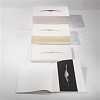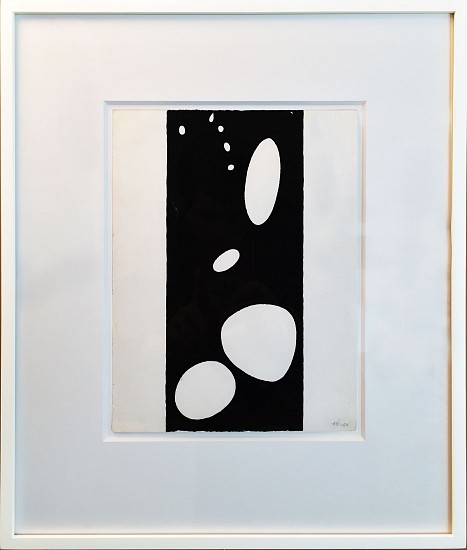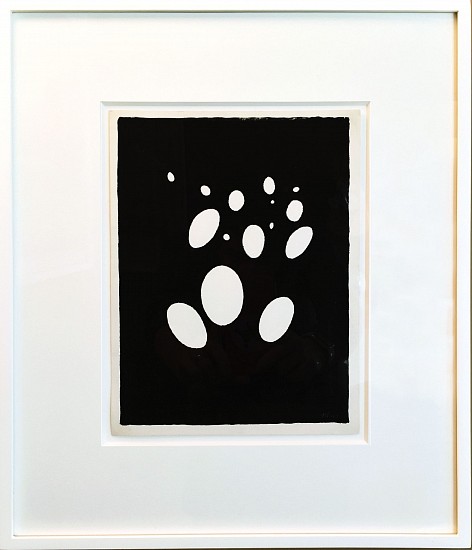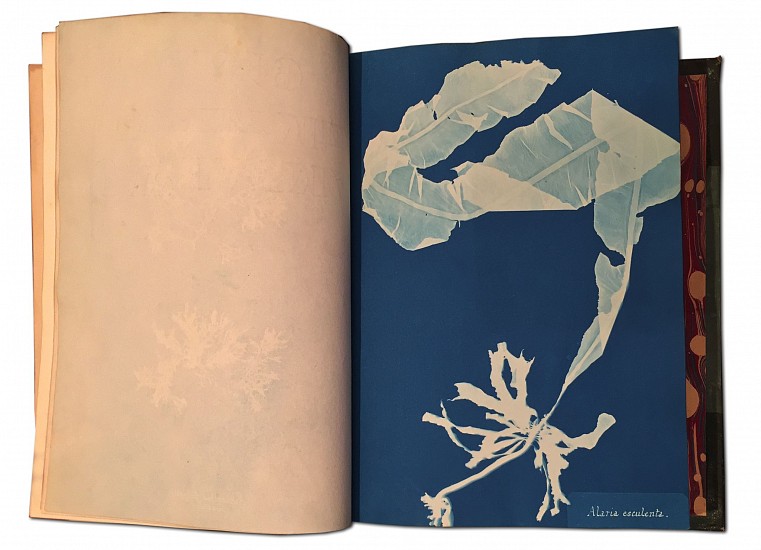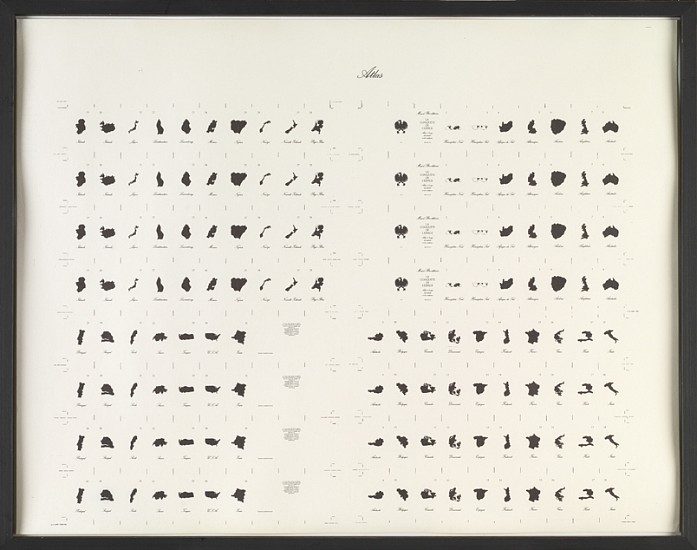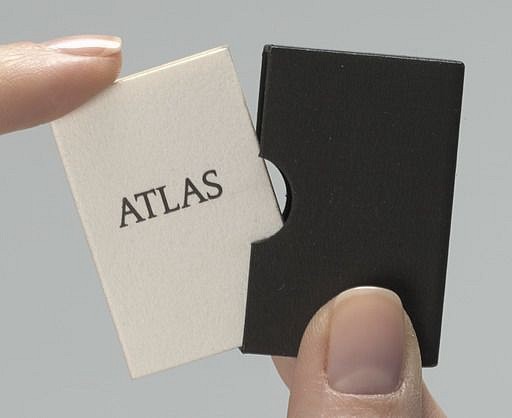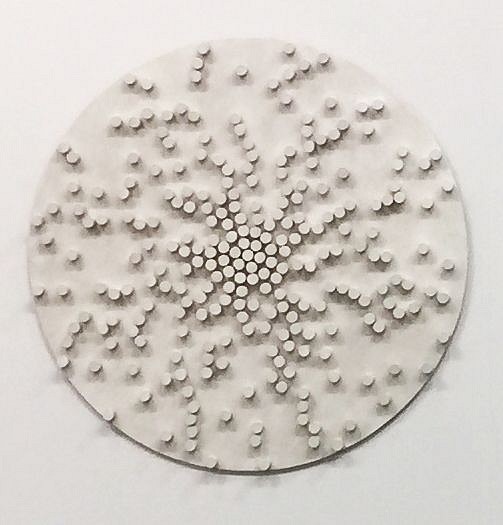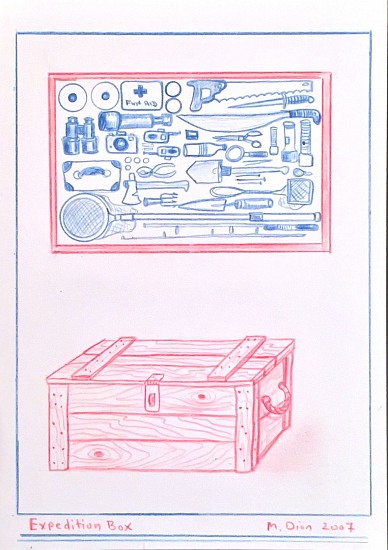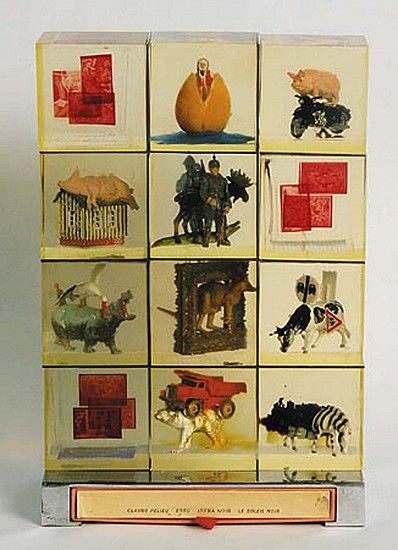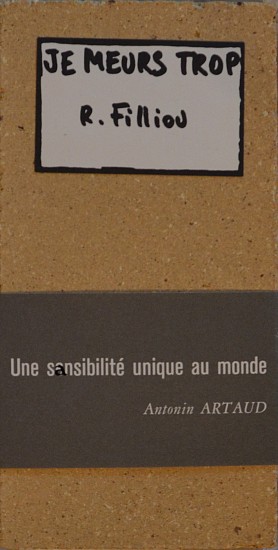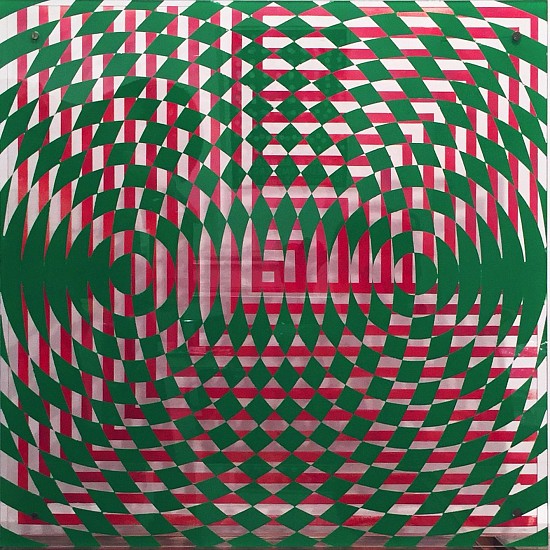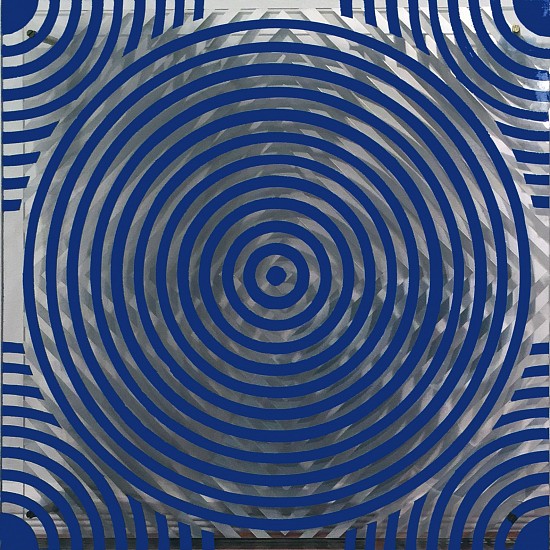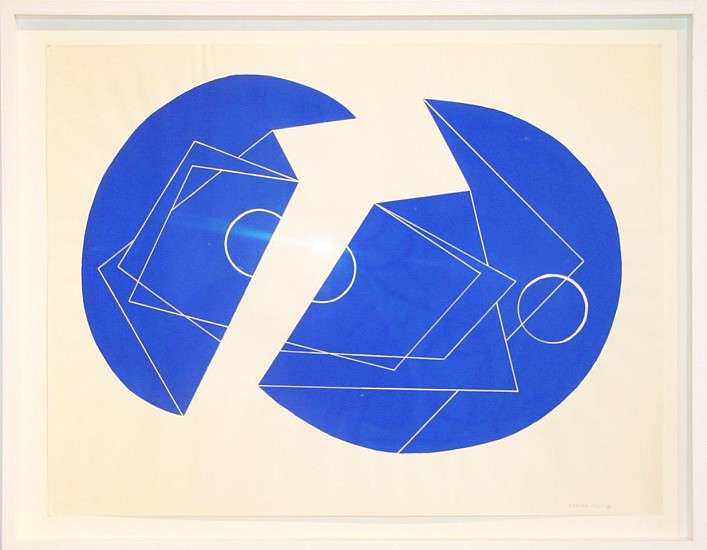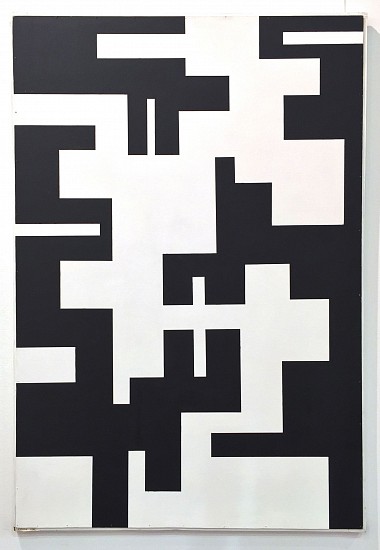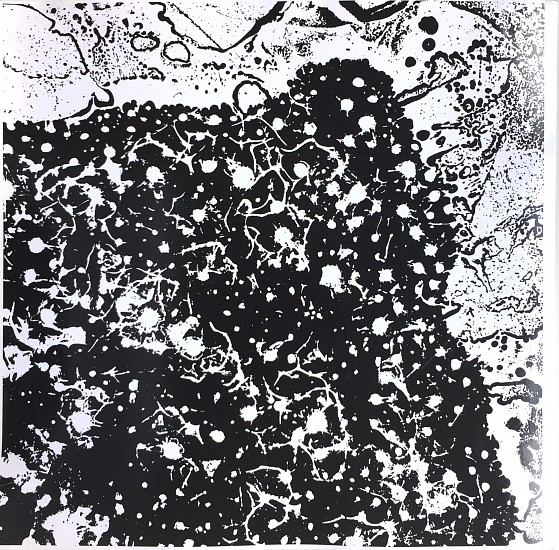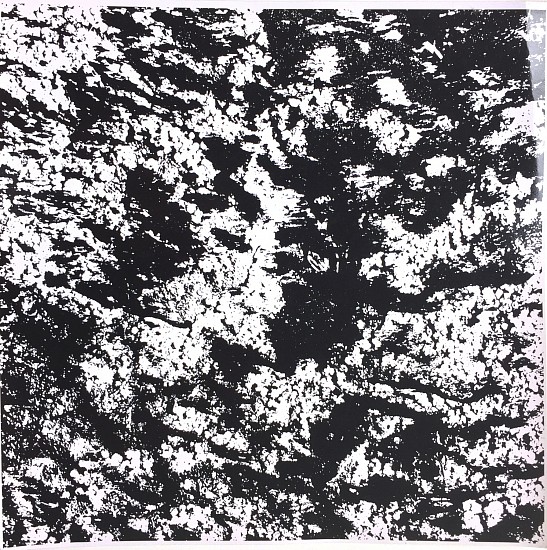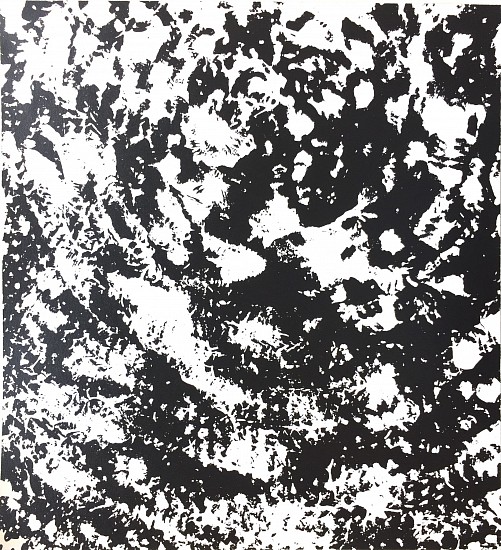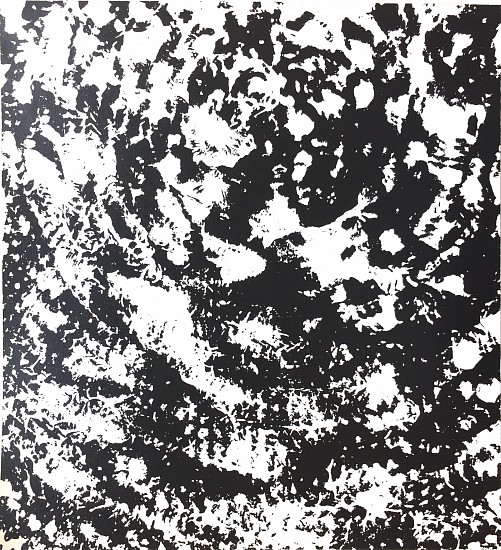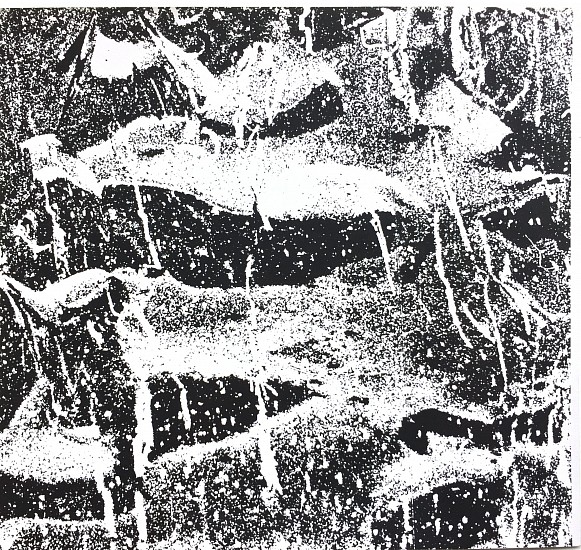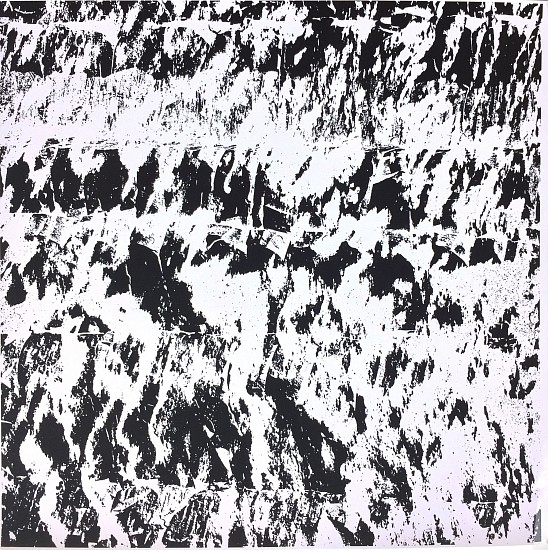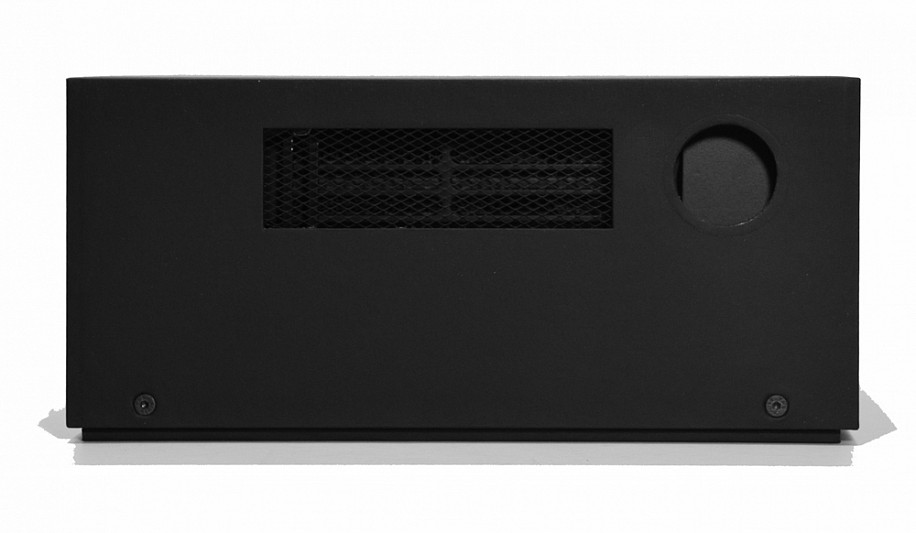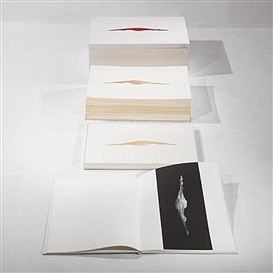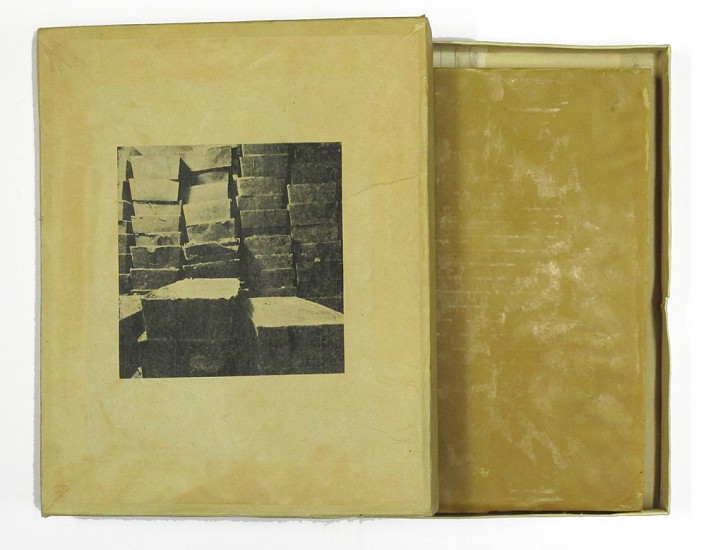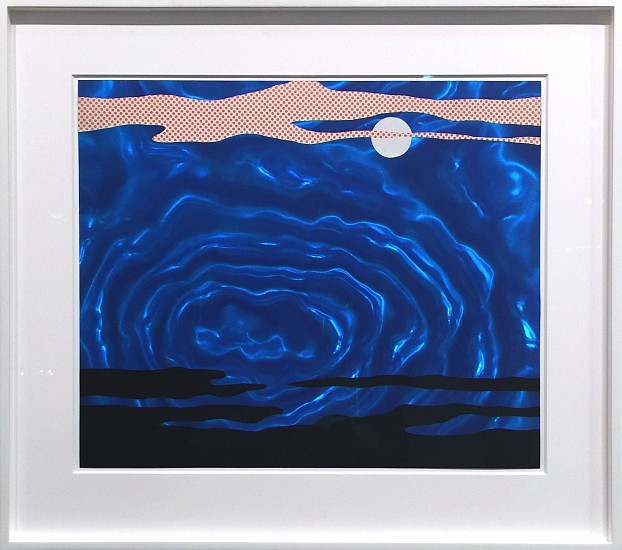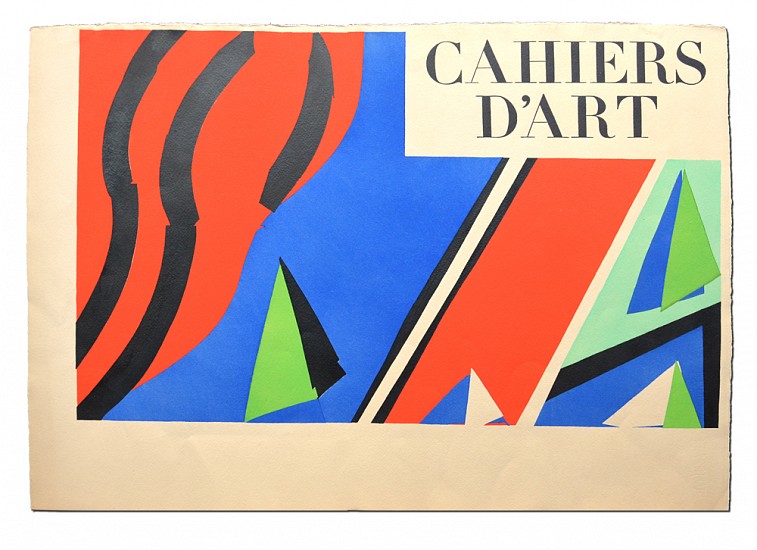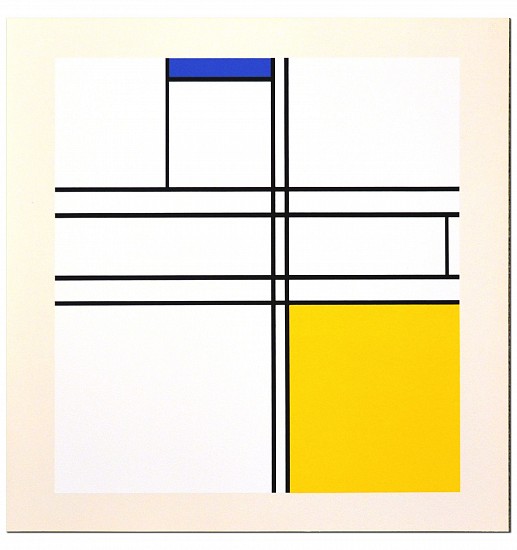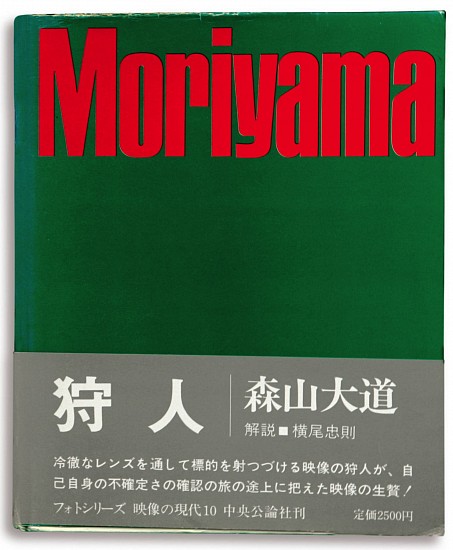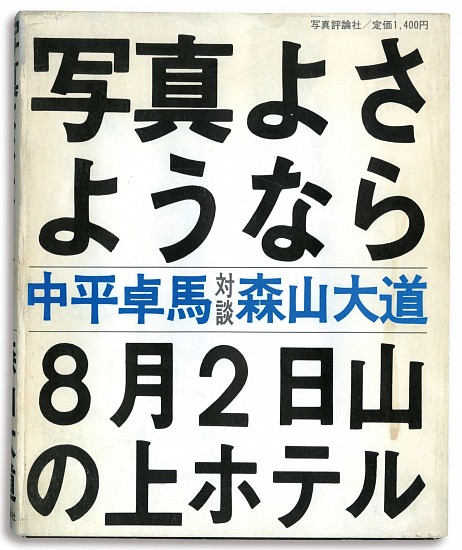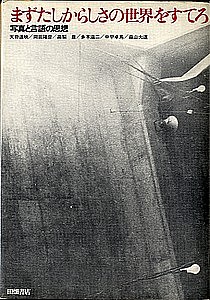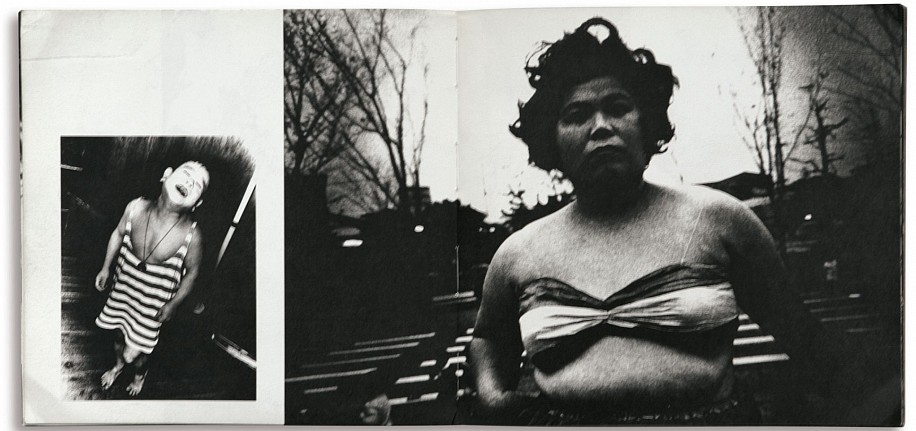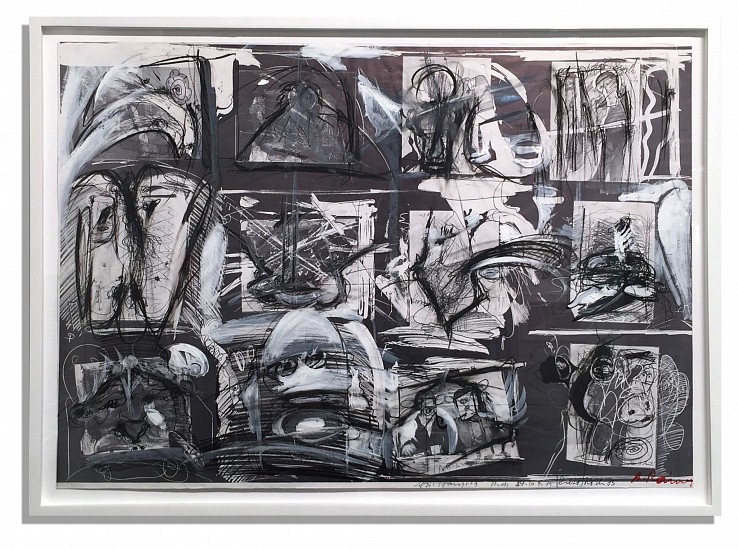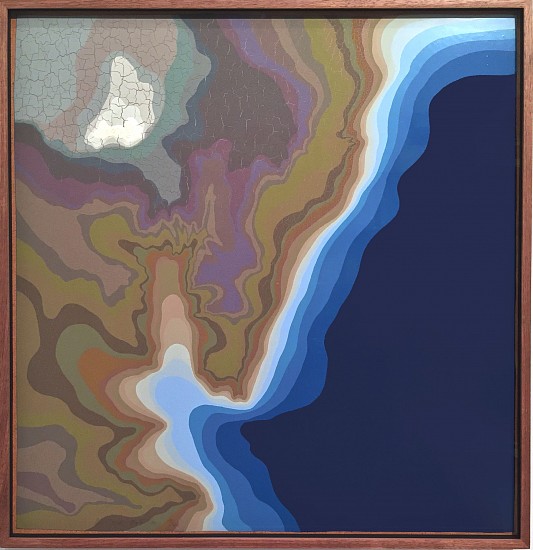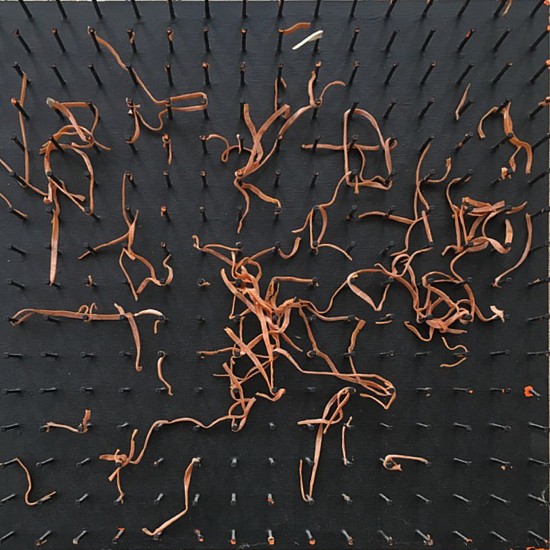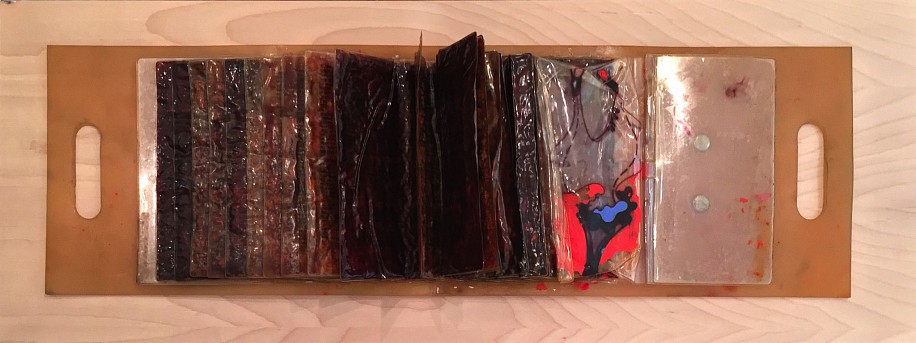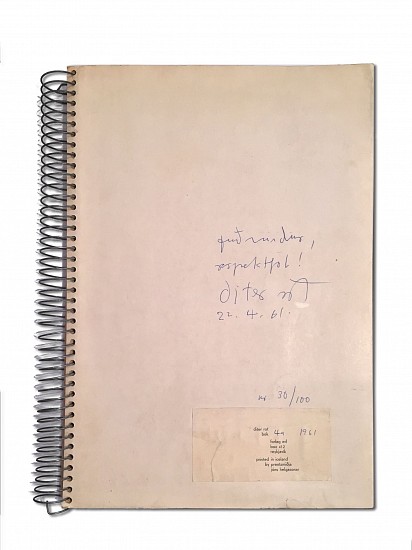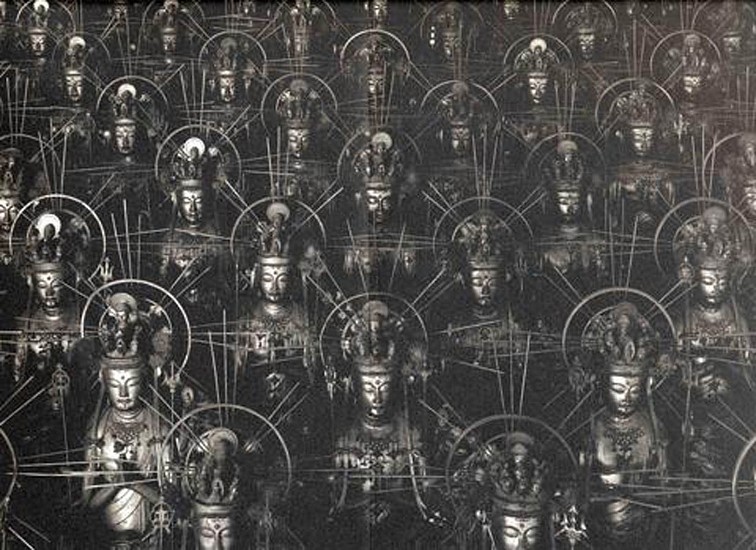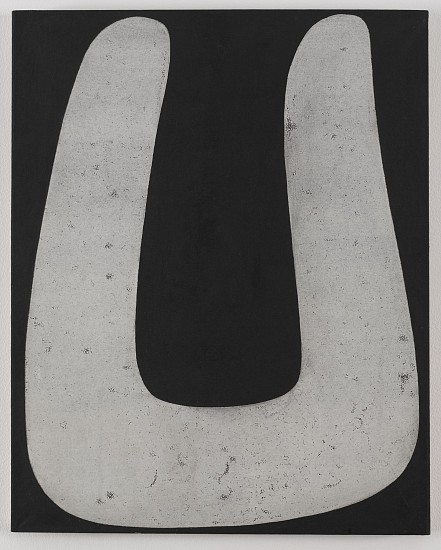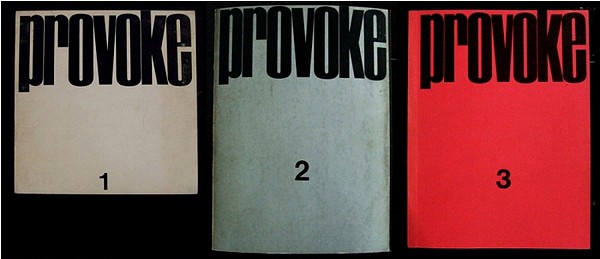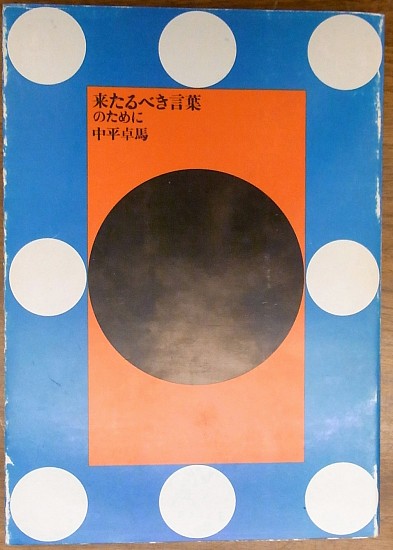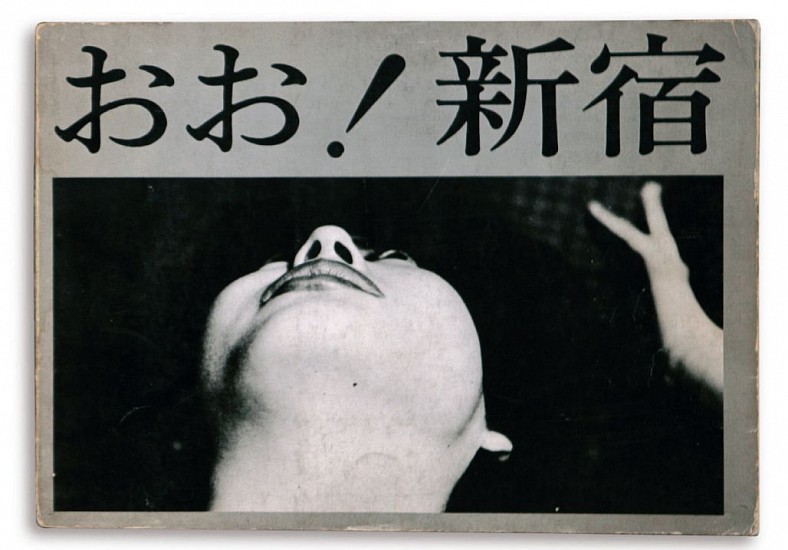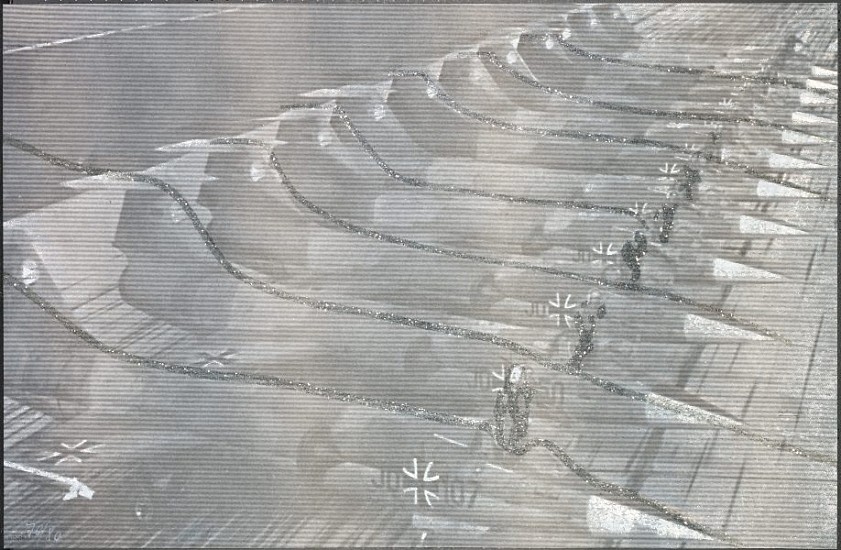The Armory Show 2016
Hordur Agustsson
Ur Formsmioju (From the workshop), 1956
3793-OR
9 13/16 x 7 7/16 in. (25 x 19 cm)
Black ink on paper, signed and dated.
Sold
Hordur Agustsson
Ur formsmioju (From the workshop), 1955
4167-OR
9 13/16 x 7 7/16 in. (25 x 19 cm)
Black ink on paper, signed and dated.
Sold
Anna Atkins
Photographs of British Algae: Cyanotype Impressions, 1843
3714-BK
10 1/4 x 8 1/2 in. (26 x 21.5 cm)
Recognized as the first book to be photographically printed and illustrated, it is a landmark in the history of photography, employing the new process of cyanotype invented by Sir John Hershel in 1842. The plates were made by placing the dry specimens on light-sensitive paper and then exposing the sheets to sunlight. Self-published and printed in a limited number of copies for private circulation, each unique, comprising 306 elegantly arranged photographic prints of seaweeds listed in alphabetical order, with captions hand-written by Atkins. This copy is a rare volume that has remained in a private library for many years; bound in green morocco leather with a hand-written inscription.
Sold
Marcel Broodthaers
La ConquÁªte de l'espace, (The conquest of space), Atlas, 1975
3776-PR
19 1/4 x 24 3/4 in. (49 x 63 cm)
Lithograph in black ink; untrimmed sheet of the pages of a posthumously published miniature book by the artist called "The Conquest of Space: Atlas for the Use of Artists and the Military".
From the edition of only 50 copies. HC copy no. VII with Estate stamp on back.
Published by Lebeer Hossmann Éditeurs, Brussels and Hamburg
Price Upon Request
Marcel Broodthaers
La Conqu√™te de l'espace, Atlas √” l”šÁ„Á´usage des artistes et des militaires, (The conquest of space, atlas for the use of artists and the military), 1975
6343-BK
1 7/16 x 15/16 in. (3.8 x 2.5 cm)
38 pages in slipcase, offset lithograph, containing silhouettes of a selection of 32 countries of the world shrunk to the same scale as Belgium, with no difference in size, arranged alphabetically. Published by Edition Lebeer Hossmann, Brussels and Hamburg. A tiny and most rare important final artist's book by Broodthaers that plays on language, scale, and function—it is transportable, but useless. This book was published shortly before the artist's unexpected death in 1976 thus all copies remain unsigned and are stamped “Estate M Broodthaers” and numbered by the publisher. Number 17 of 50 copies.
Price Upon Request
Herman DeVries
Random Objectivation (with decreasing density), 1965
6903-OR
27 1/2 x 27 1/2 in. (70 x 70 cm)
This circular wooden relief from 1965 is a paramount example of the ‘random-objectivations’ series. De Vries’s sources are either punch cards or numerical series chosen at random from the book Statistical tables for biological, agricultural and medical research edited by Fisher and Yates. Based on those codes, he developed a program that would, for example, assign a specific value to every number, that is, an x/y coordinate system that permits the deciphering of the heights, lengths and arrangement of the wooden cuboid. Combined with the omission of color, this leads to an architectural lightness that infuses the relief with a harmonious and balanced effect.
Herman de Vries created his first white collages in 1958. “As a result of an increasing drastic reduction of means†his works “became white and empty – empty also in terms of content.â€
From 1960 onwards, together with the five artists Armando, Kees van Bohemen, Jan Henderikse, Henk Peeters and Jan Schoonhoven he belonged to the Netherlandish group called NUL, which had close ties with the German ZERO group. This association lead to the publication of the journal nul=0, a journal for a new conception of art in 1961. The artistic starting point is the new beginning, the zero point, the search for an objective art that is shorn of emotional value. As de Vries stated in an interview in 1984, ‘The white pictures I created at that time are the actual turning point, the beginning of everything that would come later, to which I [...] would constantly return as a reference. It was the most important time for me personally.â€
*Single owner
exhibition history: Stedelijk Museum Amsterdam, Amsterdam, 'Atelier 2', September 24-October 24, 1965.
Price Upon Request
Mark Dion
Fragments of travel, exploration and adventure, 2007
1879
10 1/4 x 12 5/8 in. (26 x 32.1 cm)
Paris: Christophe Daviet-Thery and XN editions
In his first book project Dion assumes the guise of an 18th or 19th century scientist who explores an unknown land (he kindly includes a buffalo leather pop-up map of this terra incognita) and exhaustively documents the native flora and fauna. The book is exquisitely constructed to convincingly carry out this fiction: pieces of paper are die cut and assembled and bound into the book to suggest an impromptu but thorough record of the explorer’s discoveries and observations. Contains twenty-seven bound-in lithographs, offset printed; six bound-in digital prints; five loose lithographs, offset printed; and two loose digital prints. Edition of 36 with 9 A.P.; deluxe editions 1-6 each include a unique drawing in colored pencil. Quarter bound in buffalo leather with Zerkall Nideggen paper and Zerkall German Ingres. Slipcase.
Edition of 6 deluxe copies with original drawing.
Sold
Erro
INFRA-NOIR, 1972
2162
7 7/16 x 5 1/2 in. (19 x 14 cm)
With text by Claude Pelieu, published by Soliel Noir. Artist Book with 12 acrylic cubes with small figurines inside. Deluxe edition. Copy n 77 of 150
Price Upon Request
Rachel Feinstein
Call Us Not Weeds But The Flowers Of The Sea, 2015
6542-BK
4 5/16 x 5 7/8 in. (11 x 15 cm)
Feinstein altered a 19th century Victorian album containing mounted specimens of seaweed by adding fragments of erotic black and white photographs. She manipulates the given objects and photographs as collages that provoke voyeuristic associations. A poem on one page, nine pages of images. Unique.
Published by Edition Matthew Zucker, New York
Price Upon Request
Robert Filliou
Je Meurs Trop, 1977
3774-OR
9 1/8 x 4 3/8 x 1 1/8 in. (23.3 x 11 x 3 cm)
A brown brick with a white label attached and a grey/green label with white print wrapped around the brick. The numbers 22,11,30 are etched in the brick. Signed and numbered by the artistin an edition of 50. Text is in French by Antonin Artaud. Fireproof brick.
Price Upon Request
Eyborg Gudmundsdottir
Untitled, 1974
(19 x 19 cm)
Acrylic on 2 pieces of square cut perpsex with metal screws and spacers
Purchased directly from the artist’s widow
Sold
Eyborg Gudmundsdottir
Untitled, 1974
4773-OR
19 5/8 x 19 5/8 in. (50 x 50 cm)
Acrylic on 2 pieces of square cut perpsex with metal screws and spacers
Purchased directly from artist's widow
Sold
Eyborg Gudmundsdottir
Untitled, 1965
4793-OR
28 x 23 in. (71.1 x 58.4 cm)
Gouache on paper.
Signed and dated lower right.
Sold
Eyborg Gudmundsdottir
OLIE, 1964
4663-OR
35 x 51 9/16 in. (89 x 131 cm)
Painting on masonite mounted to frame. Signed lower corner and on back.
Exhibited at the Salon d'art Sacre at the Musée s’art moderne de la ville de Paris in 1964 and later that year at an art fair in Rouen, France. In 1965 it was also shown in Eyborg’s first solo exhibition in Iceland, published in a catalogue. Also published in a newspaper in August 1964.
Sold
Rafn Hafnfjord
Untitled(frozen lake), 1960-62
6972-PH
9 3/16 x 9 3/16 in. (23.4 x 23.4 cm)
Unique photograph
Stamped on the back
#3
Sold
Rafn Hafnfjord
Untitled(Lava), 1960-62
6992-PH
9 3/16 x 9 3/16 in. (23.4 x 23.4 cm)
Unique photograph
Stamped on the back
#4
Sold
Rafn Hafnfjord
Untitled(Lava), 1960-62
7012-PH
10 x 10 13/16 in. (25.5 x 27.5 cm)
Unique photograph
Stamped on the back
#1
Sold
Rafn Hafnfjord
Untitled(Lava), 1960-62
7022-PH
9 3/16 x 9 3/16 in. (23.4 x 23.4 cm)
Unique photograph
Stamped on the back
#6
Sold
Rafn Hafnfjord
Untitled(Frozen Lake), 1960-61
6982-PH
9 3/16 x 9 3/16 in. (23.4 x 23.4 cm)
Unique photograph
Stamped on the back
#2
Sold
Rafn Hafnfjord
Untitled(frozen lake), 1960's
7002-PH
9 3/16 x 9 3/16 in. (23.4 x 23.4 cm)
Unique photograph
Stamped on the back
#5
Sold
Jenny Holzer
TRUISMS (selections from 1977-79), 2013
4549-SC
13 3/8 x 11 1/2 x 5 7/8 in. (34 x 29.5 x 15 cm)
Digital animation with HD mini-projector in custom enclosure.
published by platypus editions, new york
Edition of 12
49-minute digital animation loop, comprised of 232 Truisms, running alphabetically in two rotations, with 32 unique animations. Powered by internal battery (1.5 hours) or AC current. Housed in a portable stormproof carrying case, with enclosure, numbered and signature stamped on the bottom.
Projection distance at 20 ft/ 6m Image Size 7ft/2m high and 10ft/3m wide. Letter Size: 1ft high
Enclosure: 8x5.5x9.5In. (20,3x14x9,5cm); Case:13x11.5x6In (34x29,5x15cm)
Price Upon Request
Anish Kapoor
Wound, 2005
3963-BK
22 x 30 3/8 x 11 in. (56 x 77 x 28 cm)
Publisher: Yvory Press
Edition : 25 copies plus one artist proof
Each edition consists of four parts. Part I is a paper-covered box, lined with paper and fabric. The lid of the box bears a hand-painted embossed design in a vivid red. Part II is a hand-bound book in white silk, containing photographs, and hand-colored facsimiles of drawings made for Wound.. The paper is handmade with Margaux Estampe white 320gsm. Part III is a paper sculpture made from two hundred and sixty-one stacked sheets of laser cut paper. Part IV is a framed sculpture consisting of fifty sheets of laser cut paper. The sheets are mounted on to a polished aluminum base and presented in a Perspex frame. Each of the four parts is signed and individually numbered by Anish Kapoor.
Price Upon Request
Wolfgang Laib
Untitled Beeswax slab, 1990
4485-BK
10 3/8 x 12 3/4 in. (26.4 x 32.4 cm)
Basel, Galerie Buchmann
Solid Beeswax slab. Issued in original cardboard box, lid printed with photograph of one of many of Laib's beeswax slabs. Artist’s multiple, published in an edition of 40 copies, signed, numbered and dated in pencil by Wolfgang Laib on the bottom of cardboard box.
Laib began working in beeswax in 1988 and has used removable wax plates to create wax rooms for exhibitions at the Museum of Modern Art, New York.
Price Upon Request
Roy Lichtenstein
Moonscape, from 11 Pop Artists I, 1965
6931-PR
23 7/8 x 19 7/8 in. (60.8 x 50.6 cm)
Screenprint in colors on blue Rowlux, signed and dated in pencil on the reverse, signed on back, edition of 200, published by Original Editions, New York. *EXCELLENT CONDITION
Printer: Knickerbocker Machine & Foundry Inc., New York
Sold
Henri Matisse
Cahiers d'Art, nos. 3-5, edition deluxe, 1936
4495-PR
15 1/2 x 22 1/4 in. (39.4 x 56.5 cm)
This special issue, in excellent condition, contains 3 parts:
1.) Thirty-eight illustrations by Matisse, mostly of female subjects, 36 of them tipped in on special paper; a text by Christian Zervos,“Automatisme et espace illusoireâ€; and a poem by Tristan Tzara “À Henri Matisse.†Printed on Montval paper.
2.) Pochoir cover after an early paper cut-out, Matisse’s first use of paper cut-outs for cover illustration. The cover was folded and wrapped around the book; however this example has an uncut, unfolded color cover with a wide margin on Arches Aquarelle paper, 56.5 x 40 cm.
3.) An aquatint, loosely inserted, L’Homme endormi, 1936; image: 24.8 x 17.5 cm, edition of 150; signed in pencil, numbered 33/150. Duthuit. Cat. Rais. Oeuvr. Illustr., n. 64, Duthuit. Oeuvre Gr., n. 771
Price Upon Request










Piet Mondrian
Portfolio of 10 paintings, 1967
5341-BK
17 x 17 in. (43.2 x 43.2 cm)
Silk screen reproductions of 10 paintings with text by Piet Mondrian and introduction by Harry Holtzman. Printer Sirocco Screenprints Inc. Published by Ives- Sullivan Inc., CT. Copy 12 of 150. List of paintings reproduced: Composition in blue and yellow; Composition in red, blue, yellow and grey; Place de la Concorde; Fox Trot A; Broadway Boogie Woogie; Abstract Painting; Composition in white, black and red; Victory Boogie Woogie; Composition; New York City I.
Very rare to find complete as most portfolios were broken up.
Sold




Daido Moriyama
Karyudo (Hunter), 1972
1759
Hardcover with authors name printed on the dust jacket. Comes with bellyband. 104 black and white photographs with a text by Tanadori Yokoo. Most of Moriyama's cult images are featured in this special monograph of the photographer's work.
Price Upon Request




Daido Moriyama
Shashin yo Sayonara (Bye Bye Photography), 1972
1760
7 1/4 x 9 in. (18.5 x 23 cm)
Tokyo: Shashin Hyoron-sha.
137 double-page black-and-white photographs printed in rich gravure. Original wrappers, with printed dust jacket. Includes 32 pages of dialogue between photographers Takuma Nakahira and Daido Moriyama.
This is the most emblematic of Provoke photobooks, in which the aesthetic principles of the movement are best expressed. Moriyama pushes the boundaries of the medium: assembling images from a variety of sources, placing them in a discordant anti-sequence, with an array of full-page grainy, blurry, and sometimes indecipherable pictures. The images were further manipulated in the dark room, in a way that results in high contrast prints with a harsh coarse grain. This rough style became somewhat of a trademark and found wide appeal with a new Japanese generation.
Shashin yo Sayonara was produced as a result of a discussion Moriyama had with Takuma Nakahira in the Hilltop (Yamanoue) Hotel in Tokyo in August 1972. The two had been friends since 1964 and both had contributed to Provoke magazine. The argument centered on the function of photography to reflect reality.
“Shashin yo Sayonara (Bye Bye Photography) is the most extreme monument of the Provoke period, indeed it is one of the most extreme photobooks ever published. Daido Moriyama pushes both the form of the photographic sequence and the photograph itself to the limits of legibility, with a brilliant barrage of stream-of-consciousness imagery culled from his own pictures, found photographs—such as shots of car accidents—and images taken from the television set. Any notion of ‘good’ technique is thrown out the window. The pictures exhibit all the qualities of reject negatives discarded in the darkroom then retrieved from the bin. The photographic language is one of blur, motion, scratches, light leaks, dust, graininess and stains ... The pace is frenetic, the image bombardment never lets up, and we reach the book's end in a state either of breathless exhaustion or on an image-fuelled high.†(Parr & Badger)
[Ref. Martin Parr & Gerry Badger, The Photobook: A History, vol.I, pp. 298-299; Andrew Roth, The Book of 101 Books: Seminal Photographic Books of the Twentieth Century, pp. 218-220; Andrew Roth, The Open Book: A History of the Photographic Book from 1878 to the Present, pp. 290-291; M. Auer, 802 photo books from the M. + M. Auer collection, p. 543; Ryuichi Kaneko & Ivan Vartanian - Japanese Photobooks of the 1960s and ‘70s, p. 29]
Price Upon Request
Daido Moriyama
Provoke 4,5, 1970
1752
Paperback with printed cover and dust jacket. The Provoke group came together for the last time, having split up in 1970, to produce these issues of Provoke magazine. Abandoning the security of the initial format, they explored new ideas around photography and language, evoking the principal revolutionary concepts evident in the first three issues.
Price Upon Request
Daido Moriyama
Nippon Gekijo Shashincho (Japan A Photo Theater), 1968
2185
8 1/4 x 8 5/8 in. (21 x 22 cm)
Paperback, title printed on the green cover, in its original cardboard slipcase. 149 black and white photographs printed using the heliogravure method. Text by Shuji Terayama. This is the first publication entirely devoted to Moriyama's work. Images are violent and dark. Deeply influenced by William Klein's New York, Moriyama transforms texture, contrast, deformation, the accidental, and abstraction into a visual language representative of the Provoke movement in Japan.
Price Upon Request
Collaboration Roth
Untitled, 1975
6123-OR
39 5/16 x 27 1/2 in. (100 x 70 cm)
Dieter Roth and Arnulf Rainer. Black crayon and white paint on offset proof sheet for the published book, Neo Nix und NEO-MIX, 1975 in an edition of 400 copies. Inscribed on bottom "For Hansjörg 29/30-4-1975" and signed by Roth in pencil and Rainer in red pen.
Price Upon Request
Dieter Roth
Relief Map, 1972
6941-PR
27 1/2 x 27 1/2 in. (70 x 70 cm)
Screen print, 33 colors, 35 printings on hardboard.
Edition of 40 copies
Price Upon Request
Dieter Roth
Gummibandbild (Rubberband Picture), 1968-81
6962-OR
18 7/8 x 18 7/8 in. (48 x 48 cm)
Canvas covered wooden board with 256 nails and used rubber bands. Initially it was painted red in 1968 and then was painted black by Roth in 1981. Signed on the back.
Provenance: Hansjörg Mayer
Price Upon Request
Dieter Roth
Poemetry, Deluxe Edition No.4 of the review 'Poeting', 1968
6071-BK
33 13/16 x 10 3/16 x 1 15/16 in. (86 x 26 x 5 cm)
19 transparent plastic bags, letterpress, printed on both sides, filled with minced mutton stitched on flexible plastic sheet. First bag with original drawing, signed and dated.
Printed by G. Hohm, Köln. Made by R. Rieser, Köln. Published by Divers Press, Köln.
Price Upon Request
Dieter Roth
bok 4a, 1961
4020-BK
15 11/16 x 11 3/4 in. (40 x 30 cm)
80 pages, letterpress on double sheets, rubber blocks in variations of triangular shapes with a spiral binding. Very rare. Printed by Prentsmioia Jóns Helgasonar, Reykjavik 1961 Edition 30/100. From the collection of Gudmundur Kristjansson, Iceland.
Price Upon Request
Hiroshi Sugimoto
Sea of Buddha, 1997
1720
48 black and white photographs, title pages and impressum folded into a Leporello (accordion style) and attached to 2 polished aluminium cover plates, contained in a silk-covered slipcase. Design by Takaaki Matsumoto.
Price Upon Request
Hiroshi Sugimoto
Sanjusangendo (Hall of Thirty Three Bays) # 30, 31 & 32, 1994
1735
16 7/10 x 21 1/2 in. (42.4 x 54.6 cm)
3 gelatin silver prints, a single image of 1001 statues at the Sanjusangendo (a temple in Kyoto). Sea of Buddha is a result of Sugimoto's desire to show the statues as they were meant to be seen during the Heian Period (794-1185). After seven years of bureaucratic red tape, Sugimoto was finally granted permission to enter the temple of Sanjusangend and the Hall of Thirty-Three Bays and photograph the Armed Merciful Bodhisattva Avalokitesvara figures, which have survived eight hundred years.
Copy n. 9 of 25.
Price Upon Request
Philip Taaffe
Untitled, 1984
7071-OR
20 x 16 in. (50.8 x 40.6 cm)
Mixed media on canvas
C29788
Price Upon Request
Taki, Koji; Takanashi, Yutaka; Nakahira, Takuma; Moriyama, Daido
Provoke (3 vol.), 1968 - 1969
1786
9 3/8 x 7 1/4 in. (23.9 x 18.5 cm)
Text by Yoshinmasu, poem by Okada. Paperback with printed cover. 110 pp. Complete collection of this legendary publication (NB: Provoke 4 appeared in 1970, after the group disbanded) uniting the most innovative post-war Japanese photographers. Breaking tradition and taboo, Provoke presented a new style—violent, dirty, embracing the accidental, the blur and shadow of social critique.
Sold
Nakahira Takuma
Kitarubeki Kotoba no Tameni- For a Language to Come, 1970
2203
12 x 8 1/2 in. (30.5 x 21.5 cm)
First edition. Paperback with illustrated cover and dust jacket; original cardboard slipcase with title and name of author printed on the covering sticker. 103 black and white photographs printed using the heliogravure method. Text by Okada Takahido. Graphic concept by Kimura Tsunesisa. Nakahira was the instigator of Provoke and, in a sense, its political conscience. This work definitely reflects the best of the group's aspirational work even though it appeared well after they split up. Mainly nighttime photographs, these images, taken between 1965-1970, have great expressive and lyrical force.
Price Upon Request



Shomei Tomatsu
OO! Shinjuku, 1969
1751
10 1/8 x 7 1/4 in. (26 x 18.6 cm)
Tokyo: Shaken.
120 black-and-white photographic illustrations. Original photo-illustrated wrappers, with text by Tomatsu printed on the back cover.
Despite the economic upturn of the 1960s, which established Japan as the third-largest economic power in the world, a fundamental opposition developed against the new political, economic, and cultural structures that had emerged in the post-war period in Japan. In 1968, the resistance manifested itself once again in university student protests against the pending extension of the “ANPO†security pact and the Vietnam War. This phase of the upheaval and alienation is documented by Tomatsu in his photo book OO! Shinjuku. A resident of the Shinjuku commercial and government district of Tokyo, he photographed the lives of the young generation and the student protests, which began in Shinjuku. Tomatsu's photographic sequences of anti-Vietnam protesters, strip clubs, and dark back alleys capture the chaos of Shinjuku in the late sixties, and illustrate the district’s central position in the mythology of postwar Japanese counter-culture.
[Ref. Martin Parr & Gerry Badger, The Photobook: A History, vol.I, p. 290]
Price Upon Request
Wolf Vostell
STARFIGHTER 1, 1967
3961-PR
20 13/16 x 32 1/16 in. (53 x 81.5 cm)
Screen print with glitter on paper. Dedicated to Herbert and Dorothy Vogel and dated 1968. There was an edition of 100; however this print is unnumbered.
Sold





















